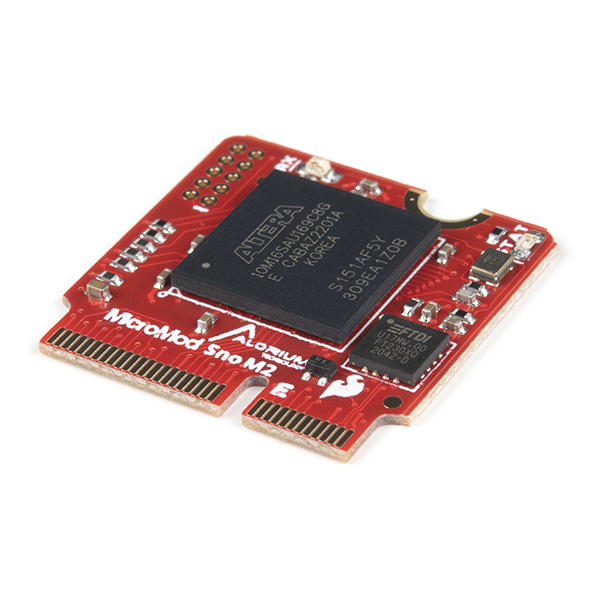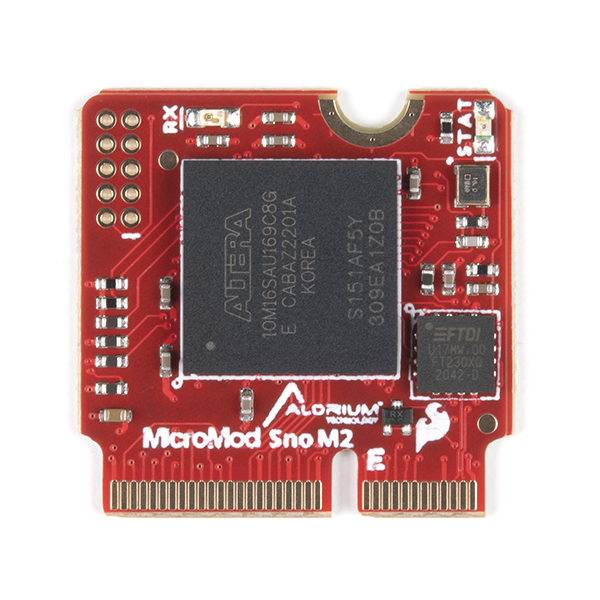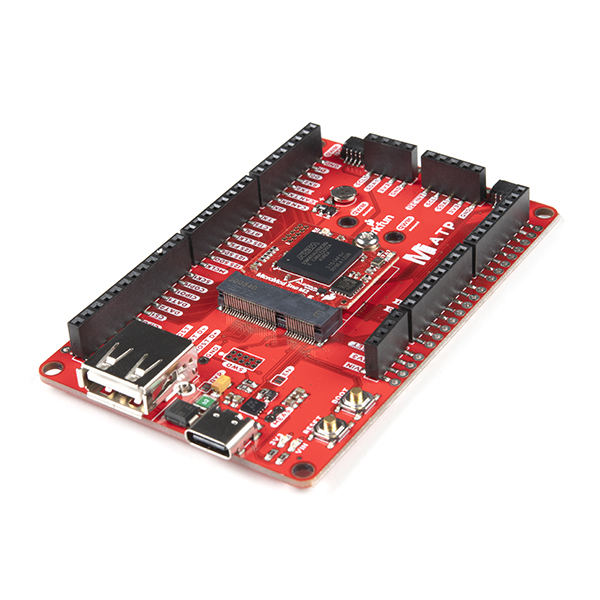SparkFun MicroMod Alorium Sno M2 Processor
The SparkFun MicroMod Alorium Sno M2 Processor features the Snō System on Module (SoM) adapted to the MicroMod M.2 processor form factor. Snō's FPGA provides a reconfigurable hardware platform that hosts an 8-bit AVR instruction set, compatible with the ATmega328, making Snō fully compatible with the Arduino IDE. Snō SoM has a compact footprint, making it ideal for space-constrained applications and an obvious addition to our MicroMod form factor for prototyping.
Alorium Technology provides a library of custom logic called Xcelerator Blocks (XBs) through the Arduino IDE that accelerates specific functionalities that are slow, problematic, or even impossible for an 8-bit microcontroller. This library includes XBs such as Servo Control, Quadrature, Floating Point Math, NeoPixel, and Enhanced Analog-to-Digital Converter. Alorium also notes a XB roadmap where future XBs will be implemented based on feedback from early adopters and new potential customers.
For advanced users, there is a JTAG footprint on the board allowing a JTAG programmer to talk to the FPGA directly. The microcontroller core has been designed to be easily extendable, and Alorium Technology has developed a support model for users who want to create their own XBs and interface to the on-chip microcontroller.
MicroMod is a modular interface ecosystem that connects a microcontroller “processor board” to various “carrier board” peripherals. Utilizing the M.2 standard, the MicroMod standard is designed to easily swap out processors on the fly. Pair a specialized carrier board for the project you need with your choice of compatible processor!
Alorium Sno Processor General Features:
- Intel® MAX® 10 FPGA (16K LEs)
- 10M16SAU169C8G
- Programmable with Arduino IDE
- Embedded 8-bit AVR instruction set compatible microcontroller (ATmega328 compatible)
- Configurable with custom Xcelerator Blocks (XBs) on the FPGA
- Programming interface: USB Serial
- Operating voltage: 3.3V
- Clock Speed 16/32MHz
Digital I/O
- 32 Dedicated Digital Pins
- 6 Shared Digital with Analog Pins
- 3.3V Inputs
- 3.3V Outputs
Analog Inputs
- 6 Analog Pins
- 3.3V Analog Reference
- ADC Performance: 1MHz
- Resolution: 12-bit sustained
- Sample Rate: 254k samples/second
Memory
- Program FLASH 32KB
- Data memory SRAM: 2KB
Specific Peripherals available on MicroMod Alorium Sno M2 Processor:
- JTAG footprint for direct FPGA programming
- M.2 keyed interface for integration with SparkFun MicroMod carrier boards
MicroMod Alorium Sno Processor Documentation:
MicroMod Documentation:
- SparkFun MicroMod Interface v1.0 - Pinout
- SparkFun MicroMod Interface v1.0 - Pin Descriptions
- Getting Started with MicroMod
- Designing with MicroMod
- MicroMod Info Page
- MicroMod Forums
- SparkFun Eagle Libraries contains example footprints for the M.2 connector and SMD standoff
- M.2 MicroMod Connector Datasheet
- MicroMod Reflowable Standoff Datasheet
Alorium Sno Documentation:
SparkFun MicroMod Alorium Sno M2 Processor Product Help and Resources
MicroMod Alorium Sno M2 Processor Board Hookup Guide
April 22, 2022
Get started with the MicroMod Alorium Sno M2 Processor Board!
Core Skill: Programming
If a board needs code or communicates somehow, you're going to need to know how to program or interface with it. The programming skill is all about communication and code.
Skill Level: Competent - The toolchain for programming is a bit more complex and will examples may not be explicitly provided for you. You will be required to have a fundamental knowledge of programming and be required to provide your own code. You may need to modify existing libraries or code to work with your specific hardware. Sensor and hardware interfaces will be SPI or I2C.
See all skill levels
Core Skill: Electrical Prototyping
If it requires power, you need to know how much, what all the pins do, and how to hook it up. You may need to reference datasheets, schematics, and know the ins and outs of electronics.
Skill Level: Rookie - You may be required to know a bit more about the component, such as orientation, or how to hook it up, in addition to power requirements. You will need to understand polarized components.
See all skill levels
Comments
Looking for answers to technical questions?
We welcome your comments and suggestions below. However, if you are looking for solutions to technical questions please see our Technical Assistance page.
Customer Reviews
No reviews yet.





